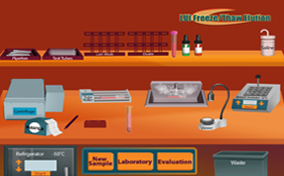What is the DAT and what does it indicate?
In the direct antiglobulin test (DAT), antiglobulin reagents containing anti-IgG and/or anti-C3d are added to a drop of freshly-washed red blood cells. When the result is positive, this indicates that there is some type of protein bound to the red blood cells. This protein can be an IgG antibody, complement, or both, or neither if drug induced.
What is an elution?
Elutions are used to release IgG antibodies from red blood cells that have become sensitized.
What is a common elution done in the clinical lab setting for ABO incompatibility between mother and baby?
There are several elution methods available, but the Lui freeze-thaw elution is primarily used when ABO hemolytic disease of the fetus and newborn (HDFN) is suspected because in ABO HDFN, the fetal red blood cells are sensitized with maternal IgG antibody. The Lui freeze-thaw elution is the easiest test to perform and requires the least amount of red blood cells.
What specimen is used to perform the elution when ABO incompatibility is suspected?
Cord blood specimen of baby collected in a 4–7 milliliter EDTA tube is used to perform the elution when ABO incompatibility is suspected.
Why do the red blood cells from the baby’s cord need to be washed multiple times prior to the elution procedure?
Red blood cells from the baby’s cord require multiple washings to remove globulins and complements that are present in the plasma. Only the antibody bound to the red blood cells should be detected.
How do you determine if the baby red blood cells have been washed sufficiently?
Determination that the baby red blood cells have been washed sufficiently is completed by saving the saline from the last wash (LW) and testing it in parallel with the eluate. The LW acts as a negative control. If this LW saline is positive, then there is unbound antibody present and the test is invalid. The sample must be washed more and testing repeated.
What is happening when the baby’s cells are frozen and then thawed?
Freezing red blood cells lyses the red blood cells freeing the antibody that was once bound to the red blood cells. This sample is then spun to separate the red blood cell stroma and antibody. The stroma goes to the bottom of the tube and the antibody will be in the supernatant. The supernatant is now called the eluate and the antibody can then be identified.
What cells are used to determine the specificity of the antibody in the eluate?
The manufactured A and B cells that are used in the reverse typing when performing the ABO testing procedure are used to determine the specificity of the antibody in the eluate. The two or three screening donor cells used in the indirect antiglobulin test in the antibody screening procedure are also used in the process.
What would you expect to see if there is an ABO incompatibility between mother and baby?
The A or B cells will be positive if there is an ABO incompatibility between mother and baby. The screening cells will be negative if the mother has a negative antibody screen.
If the mother is group O, what results would you expect to see if baby is group A or B?
If the mother is group O and the baby is group A or B, positive reactions with both A and B cells would be expected. This is due to the anti-A,B in the group O mother’s plasma that has coated the baby’s red blood cells.
 Lui freeze/thaw elution is a technique to remove antibodies from red blood cells when the suspected antibody is anti-A, anti-B, or anti-A,B. In this investigation, you will test an eluate against manufactured reagent A and B red blood cells and donor screening red blood cells to determine the specificity of the antibody.
Lui freeze/thaw elution is a technique to remove antibodies from red blood cells when the suspected antibody is anti-A, anti-B, or anti-A,B. In this investigation, you will test an eluate against manufactured reagent A and B red blood cells and donor screening red blood cells to determine the specificity of the antibody.

